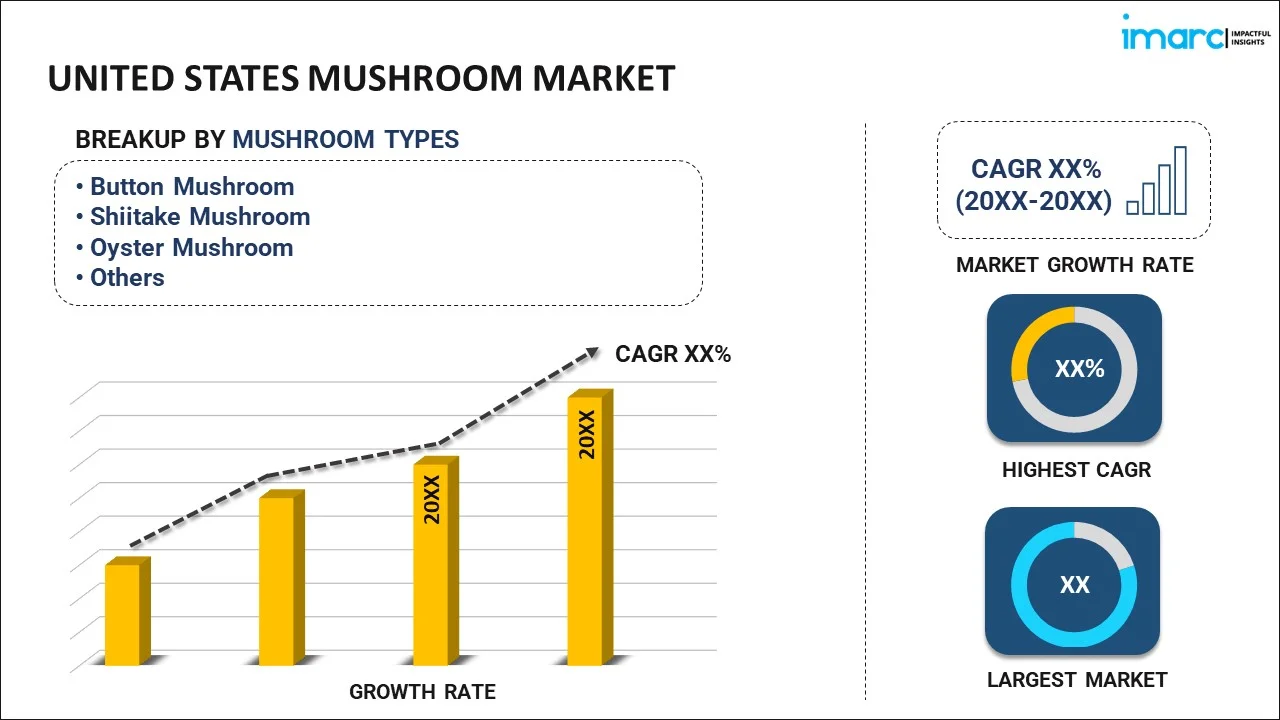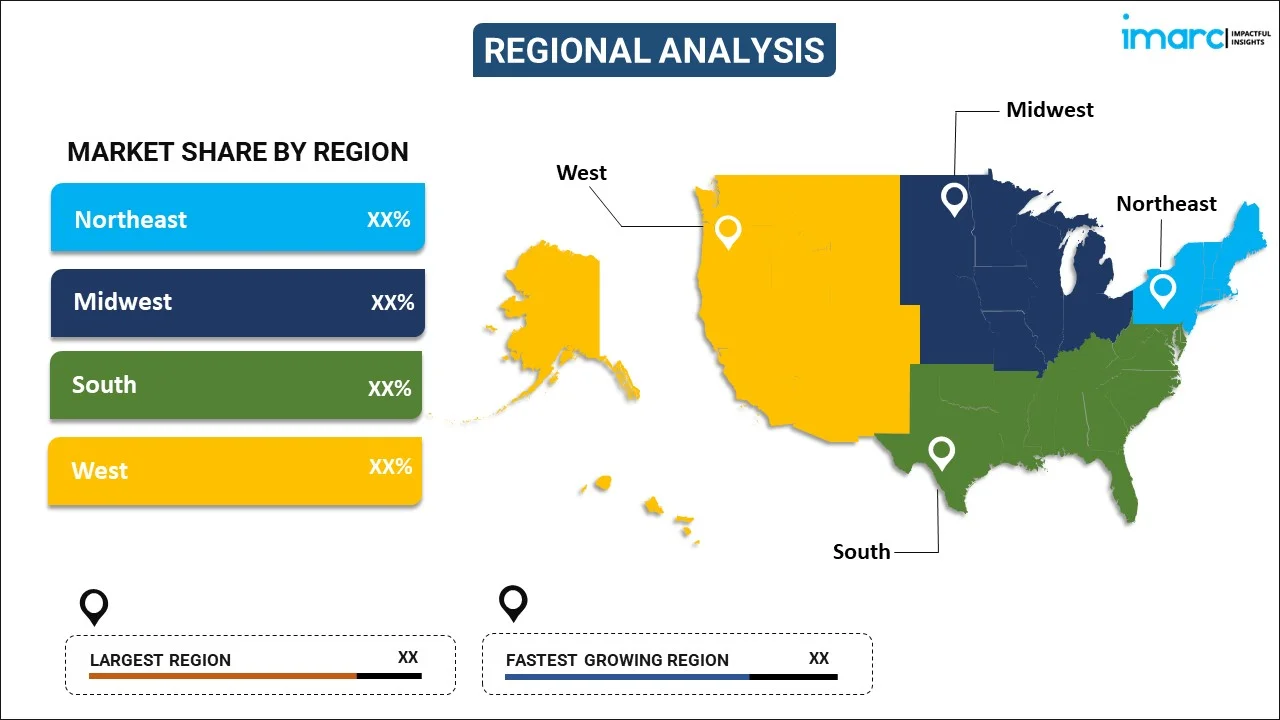
United States Mushroom Market Report by Mushroom Type (Button Mushroom, Shiitake Mushroom, Oyster Mushroom, and Others), Form (Fresh Mushroom, Canned Mushroom, Dried Mushroom, and Others), Distribution Channel (Supermarkets And Hypermarkets, Grocery Stores, Online Stores, and Others), End Use (Food Processing Industry, Food Service Sector, Direct Consumption, and Others), and Region 2025-2033
Market Overview:
The United States mushroom market size reached USD 10.7 Billion in 2024. Looking forward, IMARC Group expects the market to reach USD 23.7 Billion by 2033, exhibiting a growth rate (CAGR) of 8.6% during 2025-2033. The rise in health consciousness among the masses, the growing demand for plant-based proteins, the increasing influence of unique food trends, and the popularity of international cuisines, represent some of the key factors driving the market.
|
Report Attribute
|
Key Statistics
|
|---|---|
|
Base Year
|
2024 |
|
Forecast Years
|
2025-2033
|
|
Historical Years
|
2019-2024
|
| Market Size in 2024 | USD 10.7 Billion |
| Market Forecast in 2033 | USD 23.7 Billion |
| Market Growth Rate (2025-2033) | 8.6% |
Mushrooms, a versatile and complex class of fungi, are an integral part of both our culinary and ecological worlds. It is a versatile food ingredient, celebrated for its rich flavors, distinctive textures, and significant nutritional benefits, including high protein, fiber, vitamin, and mineral content. It varies extensively in species, with some popular types being button, oyster, shiitake, and porcini, each possessing unique taste profiles and uses in various cuisines. Its complex cultivation process involves mycelium cultivation, substrate preparation, inoculation, and harvesting. These are carried out in specialized conditions, reflecting their biological requirements and ensuring optimal growth and yield. Beyond culinary applications, mushrooms also have substantial use in pharmaceuticals and nutraceuticals owing to their bioactive compounds, such as polysaccharides and terpenoids, which have been associated with various health benefits, such as immunity-boosting and anti-cancer properties. Also, it plays a crucial role in the environment through its ecological significance. They act as nature's decomposers, breaking down organic matter and recycling nutrients back into the soil. This process is essential for the health of ecosystems, as it facilitates nutrient cycling and supports the growth of plants and other organisms.
United States Mushroom Market Trends/Drivers:
The United States mushroom market is experiencing significant momentum due to the growing awareness of the nutritional and medicinal values of mushrooms, encouraging their incorporation in a wider array of diets and supplement regimes. Along with this, the rise in health consciousness and demand for plant-based proteins is driving the mushroom market as they are recognized as a sustainable and nutrient-rich alternative to meat. In confluence with this, the influence of global food trends and the popularity of international cuisines in the United States have also played an instrumental role in the mushroom market expansion. The versatility of mushrooms to replace and complement a variety of ingredients in dishes has increased their utilization in the foodservice industry, further accelerating market growth. In addition, advancements in mushroom cultivation technologies and methods have resulted in improved yield and quality, making it more accessible and affordable. On the sustainability front, mushrooms are acknowledged for their low environmental impact and are being embraced as a component of circular economy models. They play a crucial role in waste management, as they can grow on a wide range of organic waste materials. This, combined with their fast growth rate, makes them an ideal candidate for sustainable production systems. Furthermore, the growth of online grocery shopping and delivery services in the United States has made access easier to a diverse range of mushroom varieties, thereby propelling the market forward.
United States Mushroom Industry Segmentation:
IMARC Group provides an analysis of the key trends in each segment of the United States mushroom market report, along with forecasts at the country level for 2025-2033. Our report has categorized the market based on mushroom type, form, distribution channel, and end use.
Breakup by Mushroom Type:

- Button Mushroom
- Shiitake Mushroom
- Oyster Mushroom
- Others
The report has provided a detailed breakup and analysis of the market based on the mushroom type. This includes button mushroom, shiitake mushroom, oyster mushroom, and others.
Breakup by Form:
- Fresh Mushroom
- Canned Mushroom
- Dried Mushroom
- Others
A detailed breakup and analysis of the market based on the form has also been provided in the report. This includes fresh mushroom, canned mushroom, dried mushroom, and others.
Breakup by Distribution Channel:
- Supermarkets and Hypermarkets
- Grocery Stores
- Online Stores
- Others
The report has provided a detailed breakup and analysis of the market based on the distribution channel. This includes supermarkets and hypermarkets, grocery stores, online stores, and others.
Breakup by End Use:
- Food Processing Industry
- Food Service Sector
- Direct Consumption
- Others
A detailed breakup and analysis of the market based on the end use has also been provided in the report. This includes food processing industry, food service sector, direct consumption, and others.
Breakup by Region:

- Northeast
- Midwest
- South
- West
The report has also provided a comprehensive analysis of all the major regional markets, which include Northeast, Midwest, South, and West.
Competitive Landscape:
The report has also provided a comprehensive analysis of the competitive landscape in the market. Competitive analysis such as market structure, key player positioning, top winning strategies, competitive dashboard, and company evaluation quadrant has been covered in the report. Also, detailed profiles of all major companies have been provided.
United States Mushroom Market Report Scope:
| Report Features | Details |
|---|---|
| Base Year of the Analysis | 2024 |
| Historical Period | 2019-2024 |
| Forecast Period | 2025-2033 |
| Units | Billion USD |
| Scope of the Report | Exploration of Historical and Forecast Trends, Industry Catalysts and Challenges, Segment-Wise Historical and Predictive Market Assessment:
|
| Mushroom Types Covered | Button Mushroom, Shiitake Mushroom, Oyster Mushroom, Others |
| Forms Covered | Fresh Mushroom, Canned Mushroom, Dried Mushroom, Others |
| Distribution Channels Covered | Supermarkets And Hypermarkets, Grocery Stores, Online Stores, Others |
| End Uses Covered | Food Processing Industry, Food Service Sector, Direct Consumption, Others |
| Regions Covered | Northeast, Midwest, South, West |
| Customization Scope | 10% Free Customization |
| Post-Sale Analyst Support | 10-12 Weeks |
| Delivery Format | PDF and Excel through Email (We can also provide the editable version of the report in PPT/Word format on special request) |
Key Questions Answered in This Report:
- How has the United States mushroom market performed so far and how will it perform in the coming years?
- What has been the impact of COVID-19 on the United States mushroom market?
- What is the breakup of the United States mushroom market on the basis of mushroom type?
- What is the breakup of the United States mushroom market on the basis of form?
- What is the breakup of the United States mushroom market on the basis of distribution channel?
- What is the breakup of the United States mushroom market on the basis of end use?
- What are the various stages in the value chain of the United States mushroom market?
- What are the key driving factors and challenges in the United States mushroom market?
- What is the structure of the United States mushroom market and who are the key players?
- What is the degree of competition in the United States mushroom market?
Key Benefits for Stakeholders:
- IMARC’s report offers a comprehensive quantitative analysis of various market segments, historical and current market trends, market forecasts, and dynamics of the United States mushroom market from 2019-2033.
- The research study provides the latest information on the market drivers, challenges, and opportunities in the United States mushroom market.
- Porter's five forces analysis assist stakeholders in assessing the impact of new entrants, competitive rivalry, supplier power, buyer power, and the threat of substitution. It helps stakeholders to analyze the level of competition within the United States mushroom industry and its attractiveness.
- Competitive landscape allows stakeholders to understand their competitive environment and provides an insight into the current positions of key players in the market.
Need more help?
- Speak to our experienced analysts for insights on the current market scenarios.
- Include additional segments and countries to customize the report as per your requirement.
- Gain an unparalleled competitive advantage in your domain by understanding how to utilize the report and positively impacting your operations and revenue.
- For further assistance, please connect with our analysts.
 Inquire Before Buying
Inquire Before Buying
 Speak to an Analyst
Speak to an Analyst
 Request Brochure
Request Brochure
 Request Customization
Request Customization




.webp)




.webp)












